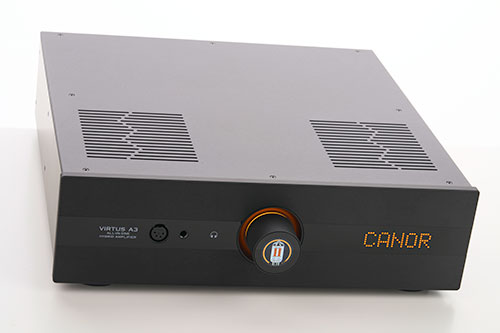
However, even if each component that has been declared to be superfluous delights the heart of every high end aficionado, the methodology of leaving the burden of amplification to the sources and the power amplifier section alone might lead through shallow waters. Negligently designed circuitries react sensitively to the cables used and their length respectively. If used incorrectly, even a volume control unit of the noble manufacturer Alps can, depending on its position, negatively influence the tonal balance. In addition to that, the output stages of the connected sources might get literally overcharged by this kind of unfamiliar task. Well, however, the mastermind behind the design is Zdzislaw Hrynkiewicz-Struss, a passionate music lover with a lot of technical expertise: a good blend in search of the perfect sound at home.
His career started way back in the seventies at the Polish Academy of Sciences. Employed there as a specialist in engineering and electronics, he narrowed his focus on the amplification of weak signal currents in the field of measurement technology. For an avowed Rolling Stones fan who couldn’t listen to his favourite band in due form, his background obviously paved the way to designing his own audio amplifier. However, a few more years were to pass before the first amplifier was produced under his name in 1995. In the meantime, he worked with Philips and the Studer AG for a few years, which gave him opportunity to further sharpen his profile. His own patents for a preamplifier circuit called Harmonics and Phase Conversion System (HPCS) bear witness thereof. The circuit is intended to combine the reproduction properties of amplifier tubes with the advantages of solid-state technology, such as control and dynamics. Should this already be a hint for the forthcoming listening test? The next few hours in the listening room will have to tell it. A blue LED and a soft click indicate the amplifier’s readiness for operation, while the two power supplies have flooded the circuit electronically in the meantime.

Many years ago, the Nits presented with Urk an excellent live recording, that documented the tour which followed their most successful studio album In The Dutch Mountains. But it’s not the hit single of the same name staged by the Dutch musicians around Henk Hofstede that starts off as my opening track, but the charismatic "Two Skaters" instead: A softly haunting song in which the kicks of the deliberately spectacularly recorded bass drum play an essential role. And the performance blows me away. The bass escapes the speaker cabinets in a powerful, unagitated and very controlled manner. And I play it just all over again, but now with significantly increased volume. I'd rather spoil the atmosphere here in the house before this amplifier even gets close to its performance limits! The space opens up widely and the recitative chant of the Dutchman is realistically projected between the speakers. The voice sounds voluminous and the hi-hat is rendered smoothly as silk.
-
Galion Audio Navy Röhrenvorverstärker
Wir haben das röhrenbestückte Vorverstärker-Flaggschiff Navy des jungen kanadischen HiFi-Unternehmens Galion Audio unter die Lupe genommen. Der Line-Vorverstärker mit vier Doppeltrioden 12AT7 (ECC81) wartet nicht nur mit hochwertigen Bauteilen auf, sondern er ist das spannende Designprodukt eines high-fidelen Überzeugungstäters. Mir sagte der Markenname Galion Audio bislang wirklich gar nichts. Das junge Unternehmen aus Québec in Kanada wurde 2020 von Thomas Tan, einem passionierten Audiophilen, YouTuber („Thomas & Stereo“) und Content Creator, gegründet. Ziel war, seine…16.12.2025 -
Eversolo DAC-Z10
Meine beiden D/A-Wandler, der DAVE im Arbeits- und der HUGO TT2 im Wohnzimmer, werden serienmäßig von Schaltnetzteilen gespeist. Bei letzterem kommt seit einiger Zeit ein Ferrum Hypsos, bei Chord Electronics Topmodell ein lineares Dreifach-Netzteil zum Einsatz. Ein solches versorgt auch den Eversolo DAC-Z10 – zum Preis von 2.000 Euro. Und nein, es sind keine drei ausgelagerten Stromversorgungen, für die der genannte Preis gilt. Dafür bekommt man das vollständige Topmodell unter Eversolos DACs. Es ist schon…09.12.2025 -
Raidho X2.6 Standlautsprecher
Mit Lautsprechern von Raidho haben wir uns bei Hifistatement schon öfter beschäftigt. Im Fokus standen dabei die Kompaktlautsprecher TD1.2 aus der TD-Serie sowie X1t und X1.6. aus der X-Serie. Diesmal haben wir den Standlautsprecher X2.6 zu Gast, das aktuell größte Modell der X-Serie. Raidho verspricht, mit der X-Serie besonders viel Leistung – sprich Klangqualität – für den aufgerufenen Preis zu bieten. Wobei, „billige“ Lautsprecher – ganz gleich nach welchem Maßstab - hat Raidho noch nie…02.12.2025 -
Canor Virtus A3
Zur diesjährigen HighEnd stellte Canor den Virtus A3 Hybrid-Vollverstärker vor. Der lockt mit einem integrierten Digital-Analog-Wandler und einer diskret aufgebauten Phono-Vorstufe für MM- und MC-Tonabnehmer. Sowohl seine Technik als auch die Ausstattung bieten Ungewöhnliches. Vor allem aber soll er klanglich beeindrucken. Das slowakische Entwickler-Team konnte mich bereits vor einem Jahr überzeugen: Der Vollverstärker Virtus I2 aus der Premium Line musizierte in meinem Hörraum wie keiner zuvor in dieser Preisklasse. Der war ein gestandener Röhren-Vollverstärker. Auch…28.11.2025 -
Dan D’Agostino Progression S350
Dan D’Agostino ist eine Legende im Verstärkerbau. Er folgte wohl nie einer Mode, sondern vertraut bei allen Entwicklungen seinem Gehör und seiner Leidenschaft für den guten Klang. Mehr als 50 Jahre baut er nun schon Verstärker, immer mit dem Ziel, das „Wesen der Musik hörbar zu machen“. Erfüllt auch der S350 diese hoch gesteckten Ambitionen? Die Progression S350 ist die kleinste Stereoendstufe im Gesamtprogramm. Optisch trägt sie alle charakteristischen Merkmale einer echten D’Agostino. Angefangen mit…25.11.2025 -
iFi Silent Power USB iPurifier Pro & Pulsar USB
Ohne iFis iDefender+ würde das PC-Audio-Setup in meinem Arbeitszimmer überhaupt nicht störungsfrei funktionieren. Dementsprechend ist es für mich eines der besten Tools im Bereich Computer-Audio. Der iPurifier Pro vereint seine Fähigkeiten mit denen eines iSilencer+ und noch mehr Features in einem Gehäuse. Außerdem teste ich das Pulsar USB-Kabel. iFi ist seit Jahren eine Konstante für hochqualitative Audio-Produkte zu fairen Preisen. Zuletzt wurde die Sparte für Stromversorgung, Kabel und Signal-Verbesserer unter SilentPower zusammengefasst. Noch bevor wir…21.11.2025
© 2025 | HIFISTATEMENT | netmagazine | Alle Rechte vorbehalten | Impressum | Datenschutz

























 |
|
















































































